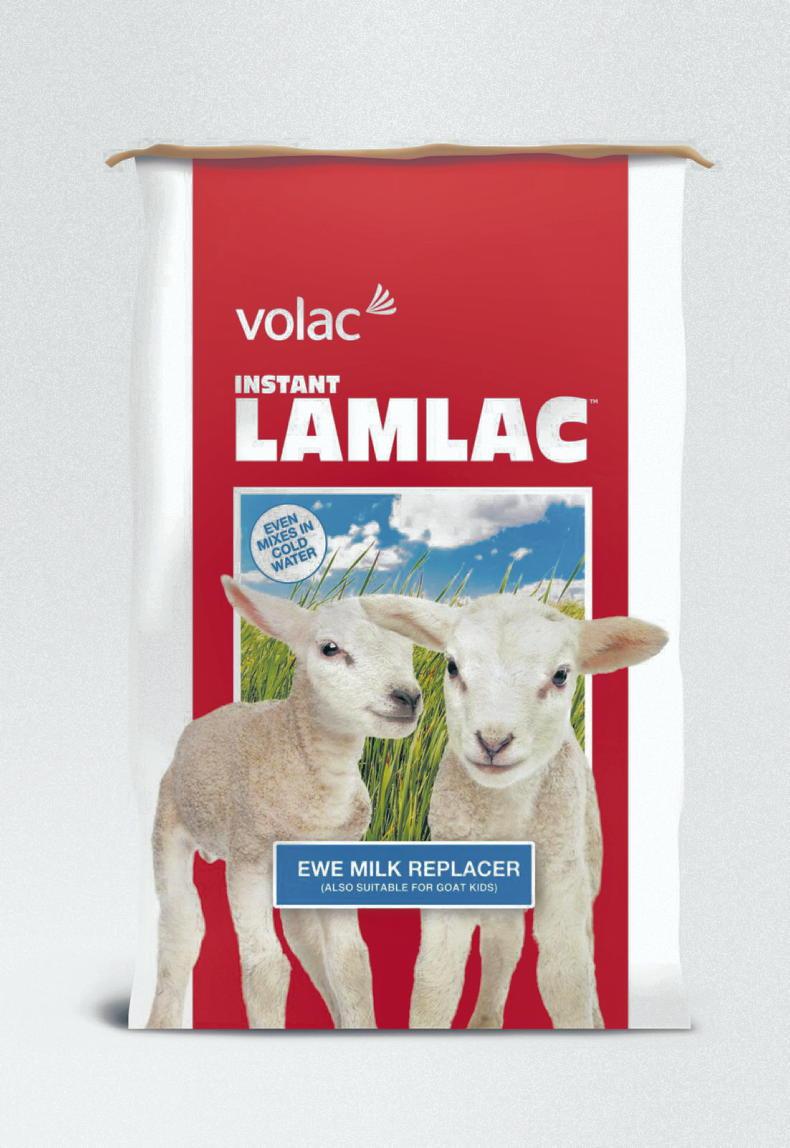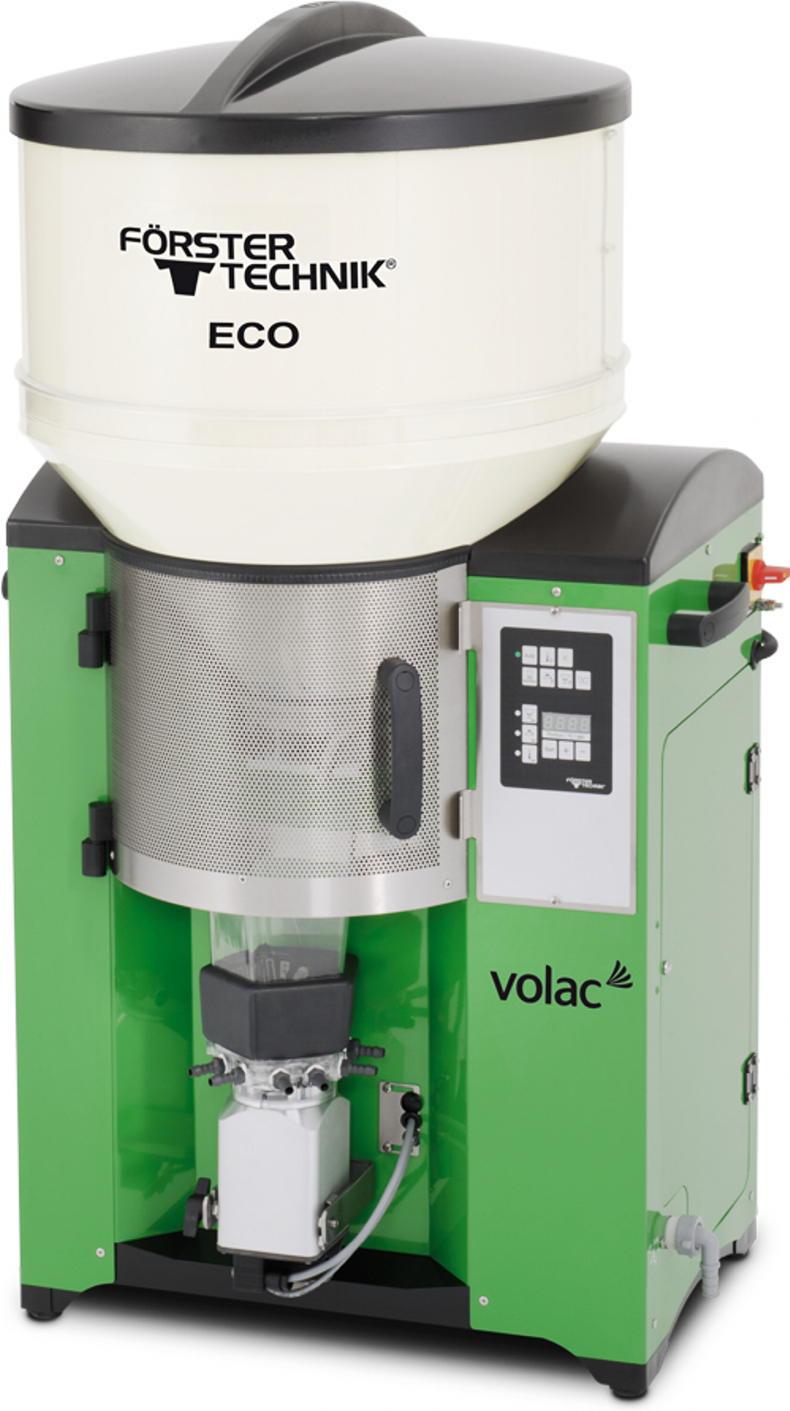Launched by Volac on the Irish market 44 years ago, Lamlac has consistently been the number one choice milk replacer for Irish sheep farmers and is still the market leader.
Containing 24% protein and 24% oil, it is formulated to supply all the vitamins, minerals, energy and proteins for maximum lamb performance. The ultrafiltrated milk proteins are highly digestible, leading to faster growth and less risk of nutritional upsets.
“Research results and farmer experience show that lambs fed on Volac milk replacer achieve growth rates of 0.4kg/day from birth to weaning.

JP Harkin; lambs reared on Lamlac perform just as well as those reared on ewes.
“Trial results and on-farm experience also show that Lamlac gives equally good performance in bottle feeding, ad-lib feeding such as the EWE2 feeder and in the Volac Eco automatic feeder.
“Many farmers have found that lambs reared on Lamlac perform just as well as those reared on ewes and are among the early bunches drafted for sale,” said JP Harkin of Volac.
Colostrum
He said that the key to health and performance in both artificial and natural rearing of lambs is to ensure that they receive adequate colostrum in the first 24 hours.
“Ideally, a lamb should receive its first feed of colostrum within two hours of birth. It should receive at least 210ml of colostrum/kg liveweight within the first 24 hours. This means that a 4kg lamb should receive a minimum of 840ml in a number of feeds.

“Where colostrum is not available or is in short supply, Volac Lamb Volostrum is an ideal substitute,” he said.
Lamlac Levels
Lambs can be fed Lamlac at around a day old. Feeding enough milk replacer is the key to healthy, profitable growth.
Depending on the rearing system, a lamb reared to weaning at 35 days of age will require up to 13kg of Lamlac. This equates to 52 litres of mixed milk replacer.
When using labour-saving ad-lib and automatic feeding systems, lambs will drink more, on a little and often basis, which reduces the risk of digestive upsets. These systems also lead to higher growth rates.

Where ad-lib feeding, do not let the milk replacer run out, as this will cause lambs to gorge when the feed is replenished.
Creep essential
Whatever the rearing system, lambs should have access to fresh water, roughage and a good quality creep feed at all times to encourage rumen development.
Lambs will begin to nibble on creep feed at seven to 10 days of age. Consumption will be low to begin with. Offering small amounts and keeping the creep feed refreshed at least once a day will encourage intake.
For effective rearing, surplus lambs should have reached the following targets at weaning:
A minimum of 2.5 times their birthweight.A minimum of 35 days old.Eating 250g of solid feed per day for 10 days.Best Lamlac Mixing and Feeding Practice
Volac’s Liam Gannon stressed the importance of mixing Lamlac milk replacer correctly.
“To make one litre of feed, add 200g of Lamlac to 800ml of water. Add half the water to all of the Lamlac and whisk until smooth. Add the remainder of the water and whisk again.
“Water used to mix milk replacer should always be below 45°C. Otherwise, the milk proteins, which are essential to lamb performance, will be damaged.

Liam Gannon
“When bottle feeding, mix and feed at 39°C. For ad-lib feeding and automatic feeders, initially train lambs at 39°C and then feed at 20°C. This will help prevent over-consumption. If feeding cold, mix and feed cold,” advised Liam.
Feeding levels
In bottle feeding, he outlined the following formula for best Lamlac feeding practice:
Day 1-3 - one litre split into four or five feeds.Day 4-7 - one litre split into four feeds.Day 7 to weaning – one and a half litres split into four feeds, reducing to two feeds leading up to weaning.Volostrum the Ideal Colostrum Substitute
Volac Lamb Volostrum is the perfect substitute when maternal colostrum is unavailable. It can also be used to supplement ewe’s colostrum.
It is based on high quality ultra-filtrated whey protein concentrate which has been processed under low temperature conditions that maintain the integrity of the globular proteins, which are essential for the young lamb.
A 50kg sachet of Volostrum provides 38g of protein compared to 28g of protein from a 140ml feed of typical ewe colostrum.
UCD trials showed that lambs fed Volostrum only after birth and reared on Lamlac had identical pre-weaning growth of 385g/day and had similar weaning weights as those fed ewe’s colostrum and also reared on Lamlac.
EWE2 a proven ad-lib feeder
The Volac EWE2 feeder is proven as an effective, labour-saving method of artificially rearing lambs.
Designed to operate safely outside the pen, it comes with mini-suckler, non-return valves and silicone tubing. The durable 300W metal heater element is easily controlled via a thermostat built into the plug.
The EWE2 has a 25-litre capacity and will rear up to 20 lambs with the standard mini-suckler. The EWE2 PLUS has a 50-litre capacity and will rear up to 40 lambs.
The Volac Eco automatic lamb feeder is a perfect option for larger flocks. It is also popular with dairy goat producers.
With a hopper capacity of 35kg of milk replacer and a heater output of 3.2kW, it can feed up to 240 lambs through eight separate feeding outlets.
It is operated from a compact control unit with a digital display enabling water and milk powder to be configured separately.

It mixes a pre-set volume of powder to a consistent, specified temperature. It also has an automatic cleaning system.
Launched by Volac on the Irish market 44 years ago, Lamlac has consistently been the number one choice milk replacer for Irish sheep farmers and is still the market leader.
Containing 24% protein and 24% oil, it is formulated to supply all the vitamins, minerals, energy and proteins for maximum lamb performance. The ultrafiltrated milk proteins are highly digestible, leading to faster growth and less risk of nutritional upsets.
“Research results and farmer experience show that lambs fed on Volac milk replacer achieve growth rates of 0.4kg/day from birth to weaning.

JP Harkin; lambs reared on Lamlac perform just as well as those reared on ewes.
“Trial results and on-farm experience also show that Lamlac gives equally good performance in bottle feeding, ad-lib feeding such as the EWE2 feeder and in the Volac Eco automatic feeder.
“Many farmers have found that lambs reared on Lamlac perform just as well as those reared on ewes and are among the early bunches drafted for sale,” said JP Harkin of Volac.
Colostrum
He said that the key to health and performance in both artificial and natural rearing of lambs is to ensure that they receive adequate colostrum in the first 24 hours.
“Ideally, a lamb should receive its first feed of colostrum within two hours of birth. It should receive at least 210ml of colostrum/kg liveweight within the first 24 hours. This means that a 4kg lamb should receive a minimum of 840ml in a number of feeds.

“Where colostrum is not available or is in short supply, Volac Lamb Volostrum is an ideal substitute,” he said.
Lamlac Levels
Lambs can be fed Lamlac at around a day old. Feeding enough milk replacer is the key to healthy, profitable growth.
Depending on the rearing system, a lamb reared to weaning at 35 days of age will require up to 13kg of Lamlac. This equates to 52 litres of mixed milk replacer.
When using labour-saving ad-lib and automatic feeding systems, lambs will drink more, on a little and often basis, which reduces the risk of digestive upsets. These systems also lead to higher growth rates.

Where ad-lib feeding, do not let the milk replacer run out, as this will cause lambs to gorge when the feed is replenished.
Creep essential
Whatever the rearing system, lambs should have access to fresh water, roughage and a good quality creep feed at all times to encourage rumen development.
Lambs will begin to nibble on creep feed at seven to 10 days of age. Consumption will be low to begin with. Offering small amounts and keeping the creep feed refreshed at least once a day will encourage intake.
For effective rearing, surplus lambs should have reached the following targets at weaning:
A minimum of 2.5 times their birthweight.A minimum of 35 days old.Eating 250g of solid feed per day for 10 days.Best Lamlac Mixing and Feeding Practice
Volac’s Liam Gannon stressed the importance of mixing Lamlac milk replacer correctly.
“To make one litre of feed, add 200g of Lamlac to 800ml of water. Add half the water to all of the Lamlac and whisk until smooth. Add the remainder of the water and whisk again.
“Water used to mix milk replacer should always be below 45°C. Otherwise, the milk proteins, which are essential to lamb performance, will be damaged.

Liam Gannon
“When bottle feeding, mix and feed at 39°C. For ad-lib feeding and automatic feeders, initially train lambs at 39°C and then feed at 20°C. This will help prevent over-consumption. If feeding cold, mix and feed cold,” advised Liam.
Feeding levels
In bottle feeding, he outlined the following formula for best Lamlac feeding practice:
Day 1-3 - one litre split into four or five feeds.Day 4-7 - one litre split into four feeds.Day 7 to weaning – one and a half litres split into four feeds, reducing to two feeds leading up to weaning.Volostrum the Ideal Colostrum Substitute
Volac Lamb Volostrum is the perfect substitute when maternal colostrum is unavailable. It can also be used to supplement ewe’s colostrum.
It is based on high quality ultra-filtrated whey protein concentrate which has been processed under low temperature conditions that maintain the integrity of the globular proteins, which are essential for the young lamb.
A 50kg sachet of Volostrum provides 38g of protein compared to 28g of protein from a 140ml feed of typical ewe colostrum.
UCD trials showed that lambs fed Volostrum only after birth and reared on Lamlac had identical pre-weaning growth of 385g/day and had similar weaning weights as those fed ewe’s colostrum and also reared on Lamlac.
EWE2 a proven ad-lib feeder
The Volac EWE2 feeder is proven as an effective, labour-saving method of artificially rearing lambs.
Designed to operate safely outside the pen, it comes with mini-suckler, non-return valves and silicone tubing. The durable 300W metal heater element is easily controlled via a thermostat built into the plug.
The EWE2 has a 25-litre capacity and will rear up to 20 lambs with the standard mini-suckler. The EWE2 PLUS has a 50-litre capacity and will rear up to 40 lambs.
The Volac Eco automatic lamb feeder is a perfect option for larger flocks. It is also popular with dairy goat producers.
With a hopper capacity of 35kg of milk replacer and a heater output of 3.2kW, it can feed up to 240 lambs through eight separate feeding outlets.
It is operated from a compact control unit with a digital display enabling water and milk powder to be configured separately.

It mixes a pre-set volume of powder to a consistent, specified temperature. It also has an automatic cleaning system.











 This is a subscriber-only article
This is a subscriber-only article





